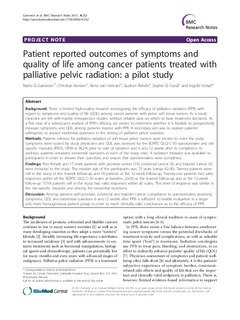| dc.contributor.author | Cameron, Marte G | |
| dc.contributor.author | Kersten, Christian | |
| dc.contributor.author | van Helvoirt, Rene | |
| dc.contributor.author | Rohde, Gudrun | |
| dc.contributor.author | Fossa, Sophie | |
| dc.contributor.author | Vistad, Ingvild | |
| dc.date.accessioned | 2011-11-11T13:24:14Z | |
| dc.date.available | 2011-11-11T13:24:14Z | |
| dc.date.issued | 2011 | |
| dc.identifier.citation | Cameron, M., Kersten, C., van Helvoirt, R., Rohde, G., Fossa, S., & Vistad, I. (2011). Patient reported outcomes of symptoms and quality of life among cancer patients treated with palliative pelvic radiation: a pilot study. BMC Research Notes, 4(1), 252. doi: 10.1186/1756-0500-4-252 | no_NO |
| dc.identifier.issn | 1756-0500 | |
| dc.identifier.uri | http://hdl.handle.net/11250/138671 | |
| dc.description | Published version of an article from the journal: BMC Research Notes. Also available from the publisher: http://dx.doi.org/10.1186/1756-0500-4-252 | no_NO |
| dc.description.abstract | BACKGROUND:There is limited high-quality research investigating the efficacy of palliative radiation (PPR) with regard to symptoms and quality of life (QOL) among cancer patients with pelvic soft tissue tumors. As a result, clinicians are left with mainly retrospective studies, without reliable data on which to base treatment decisions. As a first step of a subsequent analysis of PPR's efficacy, we aimed to determine whether it is feasible to prospectively measure symptoms and QOL among patients treated with PPR. A secondary aim was to explore patients' willingness to answer existential questions in the setting of palliative pelvic radiation.METHODS:Patients referred for palliative radiation of soft-tissue pelvic tumors were invited to enter the study. Symptoms were scored by study physicians and QOL was assessed by the EORTC QLQ C-30 questionnaire and site specific modules (PR25, CR38 or BL24) prior to start of radiation and 6 and 12 weeks after its completion. In addition, patients answered existential questions at each of the study visits. A radiation therapist was available to participants in order to answer their questions and ensure that questionnaires were completed.FINDINGS:Five female and 17 male patients with prostate cancer (14), colorectal cancer (5) and bladder cancer (3) were included in the study. The median age of the participants was 75 years (range 62-90). Twenty patients were still in the study at the 6-week follow-up and 18 patients at the 12-week follow-up. Twenty-one patients had valid responses within all the EORTC QLQ C-30 scales at baseline, 20/20 at the 6-week follow-up and at the 12-week follow-up 17/18 patients still in the study had valid responses within all scales. This level of response was similar in the site-specific modules and among the existential questions.DISCUSSION:Among patients with prostate, colorectal and bladder cancer, compliance to questionnaires assessing symptoms, QOL and existential questions 6 and 12 weeks after PPR is sufficient to enable evaluation in a larger and more homogeneous patient group in order to reach clinically valid conclusions as to the efficacy of PPR. | no_NO |
| dc.language.iso | eng | no_NO |
| dc.publisher | Biomedcentral | no_NO |
| dc.title | Patient reported outcomes of symptoms and quality of life among cancer patients treated with palliative pelvic radiation: a pilot study | no_NO |
| dc.type | Journal article | no_NO |
| dc.type | Peer reviewed | no_NO |
| dc.subject.nsi | VDP::Medical disciplines: 700::Clinical medical disciplines: 750::Oncology: 762 | no_NO |
| dc.subject.nsi | VDP::Medical disciplines: 700::Clinical medical disciplines: 750::Radiology and diagnostic imaging: 763 | no_NO |
| dc.source.pagenumber | 252 | no_NO |
| dc.source.volume | 4 | no_NO |
| dc.source.journal | BMC Research Notes | no_NO |
| dc.source.issue | 1 | no_NO |
